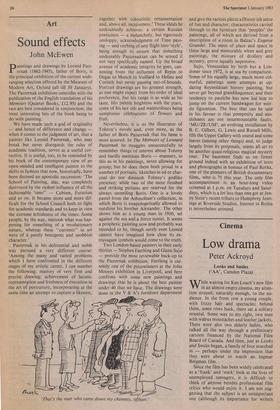Cinema
Low drama
Peter Ackroyd
Looks and Smiles ('AA', Camden Plaza)
While waiting for Ken Loach's new film in an almost empty cinema, my atten- tion strayed, naturally enough, to the au- dience. In the front row a young couple, with frizzy hair and spectacles; behind them, some rows back, there sat a solitary oriental. Some way to my right, two men with walrus moustaches and leather jackets. There were also two elderly ladies, who talked all the way through a preliminary cartoon financed by the National Film Board of Canada. And then, just as Looks and Smiles began, a family of four marched in — perhaps under the impression that they were about to watch an Ingmar Bergman film.
Since the film has been widely celebrated as a 'frank' and 'stark' look at the lives of unemployed teenagers, it is difficult to think of anyone besides professional film critics who would enjoy it. I am not sug- gesting that the subject is an unimportant one (although its importance for writers and artists has to be tested each time they tackle it), only that it is everywhere dis- cussed, and that it does not automatically guarantee excellence or interest to any film that employs it as a theme.
Looks and Smiles is set in Sheffield, which is probably stretching social realism too far. Even the food looked depressing. Two teenagers have left school and are out of work; one of them joins the Army, which in his descriptions sounds like a combination of Hitler Youth and the Blackshirts, while the other searches in a half-hearted and sporadic manner for a job as a mechanic. Neither of them seems to have much to offer, except a propensity for theft and violence, and they spend most of their time walking sullenly through the streets of this dark city or engaged in flat and empty conversations. The actors in- volved are in fact amateurs, which meant that they blended quite naturally with their surroundings.
Those who are quite ignorant of the history of 'realism' as an artistic device will claim that this is a 'frank look' at the 'plight of the unemployed'. Of course it is no such thing — its seediness is romantically in- spired, deriving from a tradition of North- ern films which may be said to have started with Room at the Top. When that tradition is mated with the conventions of television documentary, this is what we get: amateur actors in real surroundings, mouthpieces for a confused, because sentimental, por- trait of contemporary society. This is melodrama posing as realism — synthetic emotions of 'despair' and 'futility' which have been attached to 'unemployment' as a means of affording them a spurious authen- ticity.
The trouble, then, is that Looks and Smiles becomes a very dull film. For most of the time, it was as if one were listening to conversations at a bus-stop. There is a quasi-egalitarian notion, prevalent among some film-makers, that ordinary or working-class life is important and signifi- cant in itself, however you handle it; cer- tainly Ken Loach's film had the dour look of something which is meant to be good for you, even if you don't like it. It was photographed in black-and-white: just to make that clear. But there is nothing par- ticularly interesting about working-class teenagers as such, and to record their lives in a formless and uncritical manner is to compound dullness and bad art. Do you think Coronation Street would have sur- vived if it had not been well written and excellently acted?
There were moments when Looks and Smiles was so uninteresting that it exercised a curious fascination — like watching a snail cross a path, or rain falling. But the ef- fect was not a permanent one. In the future (if there is one), cultural historians (if there are any) may wonder why a good writer like Barry Hines should feel compelled to write inconsequential and often inarticulate dialogue, and why at a certain period of our history it was felt necessary to make dull films about dull people.



































 Previous page
Previous page